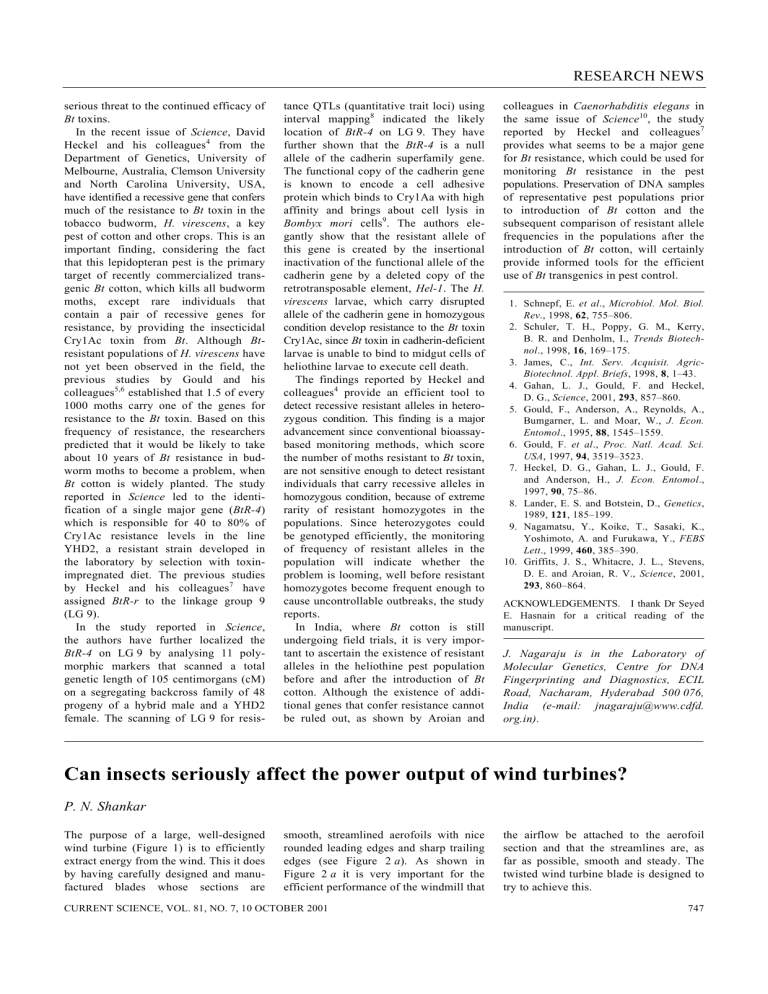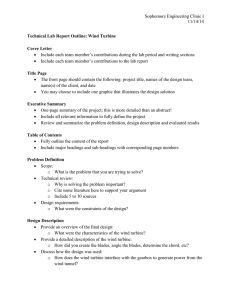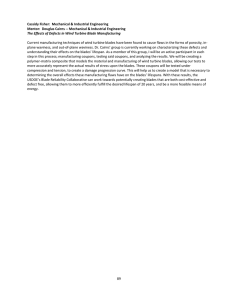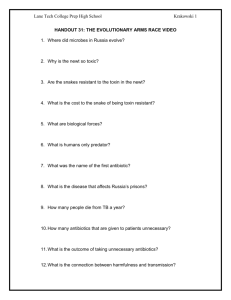Can insects seriously affect the power output of wind turbines?

RESEARCH NEWS
serious threat to the continued efficacy of
Bt toxins.
In the recent issue of Science , David
Heckel and his colleagues
4
from the
Department of Genetics, University of
Melbourne, Australia, Clemson University and North Carolina University, USA, have identified a recessive gene that confers much of the resistance to Bt toxin in the tobacco budworm, H. virescens , a key pest of cotton and other crops. This is an important finding, considering the fact that this lepidopteran pest is the primary target of recently commercialized transgenic Bt not yet been observed in the field, the previous studies by Gould and his colleagues
5,6
established that 1.5 of every
1000 moths carry one of the genes for frequency of resistance, the researchers predicted that it would be likely to take worm moths to become a problem, when
Bt cotton is widely planted. The study fication of a single major gene ( BtR-4 ) which is responsible for 40 to 80% of
Cry1Ac resistance levels in the line
YHD2, a resistant strain developed in the laboratory by selection with toxinimpregnated diet. The previous studies by Heckel and his colleagues
7
have
(LG 9).
cotton, which kills all budworm moths, except rare individuals that contain a pair of recessive genes for resistance, by providing the insecticidal
Cry1Ac toxin from resistance to the assigned BtR-r
Bt
Bt resistant populations of
. Although
H. virescens
Bt -
have
toxin. Based on this about 10 years of Bt resistance in budreported in Science led to the identi-
to the linkage group 9
In the study reported in Science , the authors have further localized the tance QTLs (quantitative trait loci) using interval mapping
8
indicated the likely location of BtR-4 on LG 9. They have further shown that the BtR-4 is a null allele of the cadherin superfamily gene.
The functional copy of the cadherin gene is known to encode a cell adhesive protein which binds to Cry1Aa with high affinity and brings about cell lysis in
Bombyx mori cells 9 virescens
Cry1Ac, since reports.
Bt
. The authors elegantly show that the resistant allele of this gene is created by the insertional inactivation of the functional allele of the cadherin gene by a deleted copy of the retrotransposable element, Hel-1 . The H.
larvae, which carry disrupted allele of the cadherin gene in homozygous condition develop resistance to the Bt toxin
toxin in cadherin-deficient larvae is unable to bind to midgut cells of heliothine larvae to execute cell death.
The findings reported by Heckel and colleagues
4
provide an efficient tool to detect recessive resistant alleles in heterozygous condition. This finding is a major advancement since conventional bioassay- based monitoring methods, which score the number of moths resistant to Bt toxin, are not sensitive enough to detect resistant individuals that carry recessive alleles in homozygous condition, because of extreme rarity of resistant homozygotes in the populations. Since heterozygotes could be genotyped efficiently, the monitoring of frequency of resistant alleles in the population will indicate whether the problem is looming, well before resistant homozygotes become frequent enough to cause uncontrollable outbreaks, the study
In India, where Bt cotton is still undergoing field trials, it is very imporcolleagues in provide informed tools for the efficient use of Bt
Caenorhabditis elegans the same issue of Science
10 to introduction of introduction of Bt
Bt
transgenics in pest control.
in
, the study reported by Heckel and colleagues
7 provides what seems to be a major gene for Bt resistance, which could be used for monitoring Bt resistance in the pest populations. Preservation of DNA samples of representative pest populations prior
cotton and the subsequent comparison of resistant allele frequencies in the populations after the
cotton, will certainly
1. Schnepf, E. et al ., Microbiol. Mol. Biol.
Rev ., 1998, 62 , 755–806.
2. Schuler, T. H., Poppy, G. M., Kerry,
B. R. and Denholm, I., Trends Biotechnol ., 1998, 16 , 169–175.
3. James, C., Int. Serv. Acquisit. Agric-
Biotechnol. Appl. Briefs , 1998, 8 , 1–43.
4. Gahan, L. J., Gould, F. and Heckel,
D. G., Science , 2001, 293 , 857–860.
5. Gould, F., Anderson, A., Reynolds, A.,
Bumgarner, L. and Moar, W., J. Econ.
Entomol ., 1995, 88 , 1545–1559.
6. Gould, F. et al ., Proc. Natl. Acad. Sci.
USA , 1997, 94 , 3519–3523.
7. Heckel, D. G., Gahan, L. J., Gould, F. and Anderson, H., J. Econ. Entomol .,
1997, 90 , 75–86.
8. Lander, E. S. and Botstein, D., Genetics ,
1989, 121 , 185–199.
9. Nagamatsu, Y., Koike, T., Sasaki, K.,
Yoshimoto, A. and Furukawa, Y., FEBS
Lett ., 1999, 460 , 385–390.
10. Griffits, J. S., Whitacre, J. L., Stevens,
D. E. and Aroian, R. V., Science , 2001,
293 , 860–864.
ACKNOWLEDGEMENTS. I thank Dr Seyed
E. Hasnain for a critical reading of the manuscript.
BtR-4 on LG 9 by analysing 11 polymorphic markers that scanned a total genetic length of 105 centimorgans (cM) on a segregating backcross family of 48 progeny of a hybrid male and a YHD2 female. The scanning of LG 9 for resistant to ascertain the existence of resistant alleles in the heliothine pest population before and after the introduction of Bt cotton. Although the existence of additional genes that confer resistance cannot be ruled out, as shown by Aroian and
J. Nagaraju is in the Laboratory of
Molecular Genetics, Centre for DNA
Fingerprinting and Diagnostics, ECIL
Road, Nacharam, Hyderabad 500 076,
India (e-mail: jnagaraju@www.cdfd. org.in).
Can insects seriously affect the power output of wind turbines?
P. N. Shankar
The purpose of a large, well-designed wind turbine (Figure 1) is to efficiently extract energy from the wind. This it does by having carefully designed and manufactured blades whose sections are smooth, streamlined aerofoils with nice rounded leading edges and sharp trailing edges (see Figure 2
Figure 2 a a ). As shown in
it is very important for the efficient performance of the windmill that
CURRENT SCIENCE, VOL. 81, NO. 7, 10 OCTOBER 2001 the airflow be attached to the aerofoil section and that the streamlines are, as far as possible, smooth and steady. The twisted wind turbine blade is designed to try to achieve this.
747
RESEARCH NEWS
Flow separates here
Figure 1. A sketch of horizontal axis wind turbines with three twisted, high performance blades each, the crosssections of which are aerofoils.
There are a number of factors that can adversely affect the performance of a wind turbine. Low and high wind speeds, gustiness and poorly maintained equipment can all lead to performance degradation.
But there are others too. Unpredictable changes in power levels have been noted in wind farms with the power sometimes falling to even a half of the expected power. Thus, for the same nominal wind speed the output may have two or even more values.
As pointed out earlier, the turbine performance is critically dependent on the flow over the blade section being streamlined and attached as in Figure 2 a .
However, there are circumstances when the flow separates from the section as in
Figure 2 b . In this case the primary flow separates from the section at some point called the separation point and beyond that point the airflow, near the aerofoil, actually proceeds in a direction in opposition to the primary flow. The latter flow is called reversed flow or separated flow. In any case, generally, such flow separation is detrimental to the performance of the aerofoil and is to be avoided. Flow separation can take place because the angle of attack is too high or because of the presence of roughness near the leading edge, for example.
Recently, Corten and Veldkamp
( Nature , 2001, 412 , 41–42) have come
Figure 2. Airflow past an aerofoil. a, Smooth, streamlined flow past an unstalled aerofoil. Note that the flow is everywhere attached to the aerofoil. b, Separated flow past a stalled aerofoil. Note that the flow separates from the upper surface at some point.
This can happen if there is roughness near the leading edge. up with convincing evidence that suggests that dead insects contaminating the leading edges of the blades can seriously affect high speed wind turbine performance.
Insects, which prefer to fly in conditions of low wind speed and high humidity, increasingly foul the leading edges of the
700
600
500
400
300 blades. At low wind speeds, when the blade angle of incidence is small, the flow remains attached in spite of the fouling of the leading edge and there is little degradation in performance. But at high wind speeds, when the so-called suction peak is high, the flow separates because of the fouled leading edge, and the performance is seriously affected.
Corten and Veldkamp obtained solid
200
100
Rough
Clean
0
4 6 8 10 12 14 16 18 20 22 24
Figure 3. Schematic of the power output from wind turbines having clean blades and ones having blades with roughness.
Note that the low speed performances are almost identical; roughness degrades the high speed performance. experimental evidence to support their hypothesis. They obtained this with the to ones whose leading edges had been artificially roughened to simulate impaca thick carbonate coating, the pump use of a novel flow separation detector fitted onto normal turbine blades and whose bearings are shot, leaking water faucets, automotive engines spewing out smoke, etc. are all worthy of our serious attention and are reminders that we need ted dead insects. They showed (Figure 3) that leading edge roughness did indeed to change to a more maintenance- conscious way of life. It is easier and degrade high speed performance.
The message is that high performance turbine blades have to be kept clean if ecologically sound to prevent waste rather than to generate new resources alone. they are to perform at peak efficiency.
But there is, in these difficult times, a broader message. We ought to examine all the equipment that we use and make
P. N. Shankar is in the CTFD Division,
National Aerospace Laboratories, Bangasure that they are maintained at peak condition. The kettle whose element has lore 560 017, India (e-mail: pns@ctfd. cmmacs.ernet.in).
748 CURRENT SCIENCE, VOL. 81, NO. 7, 10 OCTOBER 2001






